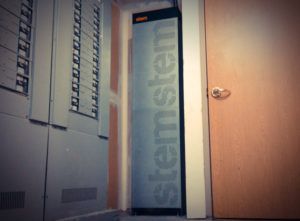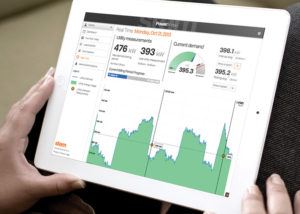STEM – making big business with big batteries

STEM does not own a factory. Yet, it is one of the most promising energy startups. By assembling the best available hardware and adding predictive analytics, STEM is able to create the grid of the future.
As the cost of batteries and renewables is steadily coming down, energy storage emerges as the new kid on the block. With more renewable energy connected to the grid and electricity prices varying greatly between peak and off-peak hours, the case for storing electricity has strong economics. And while there is undoubtedly value in storing, for example, solar energy for times when the sun is not shining, it is still unclear what business models will be able to capture the most upside.
Batteries are more or less a commodity and have historically had low margins especially with Chinese producers stepping in. Scale is king and that is also why Tesla is building a Gigafactory, putting a large bet on traditional lithium-ion battery technology. Other companies have figured out that it is not the battery itself that counts but how that battery is integrated, understanding when and how energy is used, and dispatching that energy at the right time back to the grid.
Energy storage for businesses will never be the same.

California-based STEM does not own a factory. And still, its bread and butter are large-scale commercial storage systems. The company assembles battery cells and power electronics made by others and adds a software layer. Its software is able to analyze the user’s energy demand and predict when and how much will be used. It charges the system during times of low electricity prices and discharges when rates are high, saving the customer from paying expensive peak electricity prices.
What has STEM figured out that others haven’t?
-
Let others make the Hardware
STEM is in the energy business, which is infamous for high capital costs and slow growth. Yet, it has been able to create an asset light hardware-agnostic business model, which allows the company to take advantage of the falling prices of batteries and easily change between different chemistries or suppliers. On the power electronics side (making AC from DC electricity), STEM has innovated and configured its own system of inverter, charger, and battery management system (BMS).
-
Use Predictive Analytics/Deep Learning

While not only assembling the most up-to-date technologies, the startup’s main competitive advantage is its ability to analyze and predict energy demand. The software “learns” the customer’s unique energy profile and displays real-time predictions of energy demand. Moreover, the system also makes recommendations on how and when to save energy. As the CEO noted, “We are transforming the way people use electricity without changing what they do.” In that sense, the system is adaptable to the needs of the customeracross various businesses and verticals.
-
Get $$ from Businesses + $$ from Utilities
STEM is able to sell its intelligent storage systems to businesses and provide them with the ability to arbitrage between peak and off-peak electricity prices, regardless if they have solar on their roof or not. For utilities, the company is able to aggregate numerous storage systems across its business customers and dispatch them as a single flexible “unit”, adding extra capacity to the grid, i.e. acting as a power plant run solely on a swarm of batteries. For example, the more renewables are connected to the grid, the more there will be fluctuations in energy supply when there is a cloud or the wind stops blowing. STEM’s system can counter exactly those fluctuations, guaranteeing a reliable source of energy. Hence, the more STEM grows, the more stable the grid becomes (indeed, that is a network effect!).
STEM has raised $205M to date including funding from leading investors such as Angeleno Group, Iberdrola, GE Ventures, Constellation New Energy, Total Energy Ventures, Mitsui & Co, and RWE. A large milestone for the company was a funding round of $100M in 2016 for project finance, invested by Starwood Energy Group.
Many energy storage startups have attempted to innovate on the hardware side of storage, but STEM is one of the few players in the space who have been able to create an integrated digital solution, which benefits both businesses and utilities and contributes towards a smarter grid. The startup has created an innovative business model, which is able to capitalize on large-scale projects such as its 1MW distributed storage project in Hawaii or its large contracts with Southern California Edison and New York’s Con Edison.
Will STEM be able to sustain this advantage? Who will win the storage game?





This sounds very innovative and B2B is the way to go. What’s your view on the competitive landscape? What makes its technology difficult to copy
I think this is a great idea but have some questions around the long-term viability. Battery technology has not changed much over the past few decades, so there is a degree of predictability that the software can make use of. With a renewed focus on improving storage, new battery technologies may emerge that behave unpredictably and require an entirely new learning curve. Do you see anything that STEM has done to fortify themselves against this risk?
Thanks LiDe. Fascinating read. How adaptable is STEM’s business model to changes in battery technology? Does Tesla run its own proprietary software on their batteries? My biggest concern will be an ecosystem in which battery producers start building barriers for external software players to run their systems with third party battery hardware and thus dry the business opportunities that STEM has promised to go after.
Thank you for the comment, Techie and apologies for responding so late. As you point out, STEM can change the technology it uses easily – it acts more like a software platform. Hence, it is possible to also change the business model slightly as technology changes and the competitive landscape as well as regulations change as well over time. They already have some market channels that have been working pretty well, so I assume that they will adapt their sales and marketing efforts as well as the competitive landscape changes as well. It is true that the biggest threat for them is to just be replaced by the software solutions that the actual battery producers create. For example, Tesla is both making batteries at the Gigafactory in Nevada, but it is also making its own optimized software solution that runs the batteries and will soon even integrate with the solar panels that SolarCity makes. So I agree that the threats are real and imminent – so STEM needs to closely watch its competitors and stay on top its proprietary software innovations.